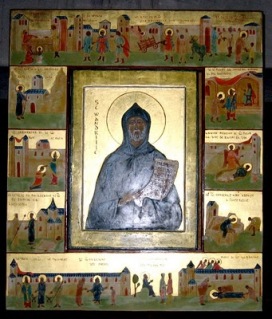A quiet day on the British calendar; I’ve updated St Helier’s post with a troparion, and here are a couple more for today from
Acathistes et offices orthodoxes.
Ton 5 Tropaire à saint Domnin, martyr, (natalice au 3ème siècle)
L’Ecriture dit que la louange parfaite,*
Est issue de la bouche des petits enfants.*
Saint Domnin, tu n’étais âgé que de dix ans,*
Lorsque tu fus crucifié en haine du Christ,*
Avec d’autres chrétiens à Avrilly dans l’Eure.*
Saint innocent, prie le Seigneur de nous sauver!
Scripture says that perfect praise
Comes from the mouths of little children.
St Domninus, you were only ten years old
When you were crucified by those who hated Christ
With other Christians at Avrilly in the Eure, in Normandy.
Holy innocent, pray to the Lord to save us!
The relics of St Dominin were translated to Puy-en-Velay in the Auvergne.
+
Ton 6 Tropaire à saint Généroux, higoumène, (Natalice au 6ème siècle)
Romain de naissance, tu te fis religieux*
Au monastère sacré de saint Jouin de Marne.*
Tes éminentes qualités spirituelles,*
Te firent bientôt élire comme higoumène.*
Saint Généroux, toi qui es auprès du Seigneur,*
Prie-Le d’avoir de nos âmes grande mercy!
Roman by birth, you became a monk
Your distinguished spiritual qualities
Soon caused you to be elected abbot.
St Generosus, you who are close to the Lord,
Pray to Him to have great mercy on our souls!
=====
‘St. Sinach MacDara, 6th century. The only reference I can find to Sinach is that the fisherman traditionally gathered on the island of MacDara for an annual Mass. It is still customary to dip sails or make the Sign of Cross when passing the island (Montague).
‘St. Tenenan (Tininor) of Leon, Bishop. Born in Britain; died c. 635. Tenenan was a priest who became a hermit in Brittany and later bishop of Leon. He probably died at Ploabennec, where he had built a forest hermitage and where his relics were long venerated (Benedictines, Farmer).’
===
And another source, many more early western (especially French) saints, posted by ‘Claude le liseur’ who I think is probably M Lopez-Ginisty of
Acathistes et offices orthodoxes, at
forum-orthodoxe.com

